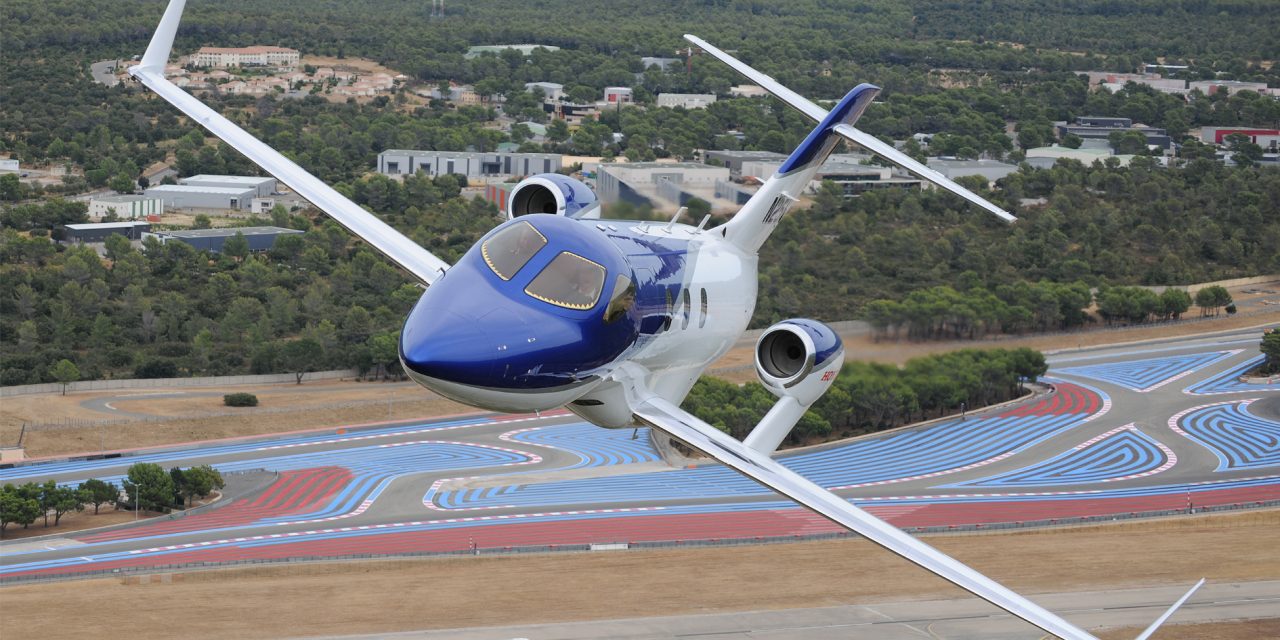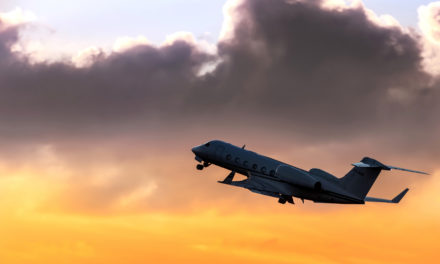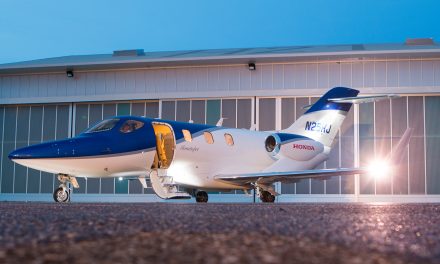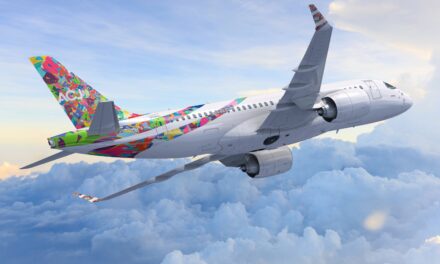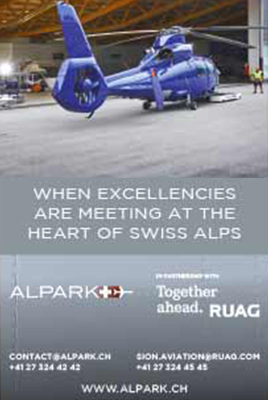It is with great pleasure to meet up with my old friend Gilles Ruzel, with whom I last flew 14 years ago during our years in the Military, and especially to discover this spectacular aircraft: the Hondajet HA-420.
Recently certified in the United States and Europe, he has been flying the third European aircraft for several months. The twinjet will soon be joined by a small fleet that will fly under the colors of FlyHondaJet, the company that will be privately operating them throughout Europe. This small jet took its time before hitting the skies and we are looking forward to seeing its innovation in detail and experiencing its performance.
From the start, Honda presented this aircraft as being totally different from what was currently on the market. This cutting-edge development is particularly visible with its over-the-wing engine design via their respective pylons that are not in contact with the fuselage. In addition to saving cabin space and better auditory comfort, this provides improved aerodynamics with less drag offering better performance in terms of cruise speed and fuel consumption.
Its sights are certainly set on performance. The HondaJet announced an indicated airspeed of 422 kt at FL310, a maximum operating ceiling at FL430, with a maximum rate of climb of 3990ft/min, takeoff distances around 4000 ft (1220m) at maximum takeoff weight, and landing distance of 3300 ft (1,006m). The flying range with four people on board is around 1,220Nm (NBAA IFR fuel reserves). This performance data undoubtedly classifies the aircraft as one of the most powerful in the category of business twinjets under 20,000lbs (HondaJet Max Takeoff Weight: 10,600 lbs). In terms of consumption, the figures announced are also ambitious with the best consumption in its class on typical “routes” of 600Nm in “Long Range Cruise” and a reduced ecological impact, compared with its competitors, due to the low rate of nitrogen dioxide emissions*.
Aircraft tour
The weather looks perfect for this flight to Avignon to test the HondaJet in its standard environment. Gilles takes me on the owner’s tour. The jet, registered N25HJ, is 42ft long and has a wingspan of 41ft which seems a reasonable size. The wings, with their large and solid winglets uphold the GE Honda engines at the end of their over-the-wing mounts. The shape from the front of the cabin and the layout of the windows of the cockpit give the aircraft a very particular look, which reminded me of a small fighter jet or even a bird of prey.
Gilles Ruzel explained that the positioning of the engines offers a genuine advantage in terms of drag reduction, flight stability, space savings and auditory comfort in the cabin.
Honda has thought of everything. If you are not tall enough to reach the oil compartments on the side of the engines, there is a retractable stool stored in the aircraft’s nose compartment. The HA-420 has a single refueling point on the back right of the fuselage. The 2,850lbs capacity fuel tank is filled by gravity, which does not prove to be challenging and allows for refueling at most “small” general airfields. The large luggage compartment located on the back left side of the fuselage behind the engine, is easily accessible thanks to its forward-retractable door that enables the most cumbersome luggage to be loaded without a problem. With its 400lbs (180kg) in a little less than 2m3, the space-saving design is due in particular to the positioning of the engines being mounted on the wings, as opposed to the fuselage. These GE/Honda Aero Engines HF-120-H1 engines and their superb curved fan blades develop 2,000lbs of thrust each in ISA+10 conditions.
We take our seat on board accompanied in the rear by three people including Gilles’ partner, Gregory Mansiat, Chief of Operations for FlyHondaJet. The stairway allowing access to the cabin was also studied in terms of design and practicality: solid steps with no holes to avoid trapping high heels that transforms into a tablet once the door is closed. The cockpit while relatively small remains quite habitable once settled into its very comfortable seats, equipped with multiple settings. The Garmin 3000 avionics suite, the three giant screens (MFD – Multi Function Display), the lack of dials, instruments and “old-school breakers” (hidden in the armrests) add to the streamlined aspect of the cockpit design. My eye was drawn to the “Engine Start” switch that looks like it belongs in a Japanese luxury car.
In flight
We get started simply by pressing on one of these switches. The FADEC system does the rest while Gilles has just enough time to show me how the GTC (Garmin Touch Controls) screens work which provide intuitive control over all aircraft systems and display the information on our Primary Flight Display (PFD) and MFD. After the check list, we are authorized to taxi and we waste no time to ensure we do not lose our takeoff slot. The aircraft uses nose-wheel steering which proves to be easy to use especially for a machine of this size.
Once lined up and cleared for takeoff, I set our takeoff power and we can clearly feel the thrust of our two HF-120. The speeds are displayed on the speed tapes of our PFDs, and once past the V1 decision speed of 110 kt, it is already time to perform the rotation at 115 kt. I then easily display a climb attitude of around 15°.
Gear and flaps are quickly retracted, and I continue to hand-fly the airplane throughout our instrument departure. Required control inputs on the yoke are quite light, and I use my pitch and roll trim controls, located under my right thumb, only during the transient phase to accelerate to our optimal climb speed of 210 kt.
I switch from manual to autopilot and check our Vertical Speed Indicator (VSI) reading 3400 ft/min climbing through 10000 ft, quite a little fighter jet! The management of autopilot is standard,through controls located on the upper banner, and the GTC can be used to manage absolutely all systems and the numerous automated features of the aircraft with just a touch. There are numerous functions and Gilles shows me how to configure them and customize an avionic “profile”, specific to each pilot, in order to save the information settings… brilliant! Our climb rate decreases significantly but we pass FL360 in 17 minutes and stabilize at FL390 in 21 minutes.
Once stabilized in high-speed cruise, I note a true speed of 405 kt with consumption of 800lbs/hr (ISA+5 conditions). The performance really does live up to the hype!
I perform the verification of various aircraft systems while cruising and I appreciate the simplicity of the synoptics displayed via our GTC on the MFD or our PFD. My “pilot in command” for the day shows me how to use the weather radar and download weather maps in real time via the Iridium satcom link. These elements greatly simplify a pilot’s life especially when alone in the cockpit. On three large screens, four customizable tiles controlled by each GTC are used to indifferently display all systems synoptics, the weather radar, as well as many different other navigation, traffic and weather maps, approach charts, and also our exact taxi position on airport diagrams with complex taxiway layouts.
The zoom function via the GTC allows for easy viewing by using your finger just like on a tablet. The PFD synthetic vision options as well as the visual and audio alerts of the SafeTaxi system provide excellent cockpit visibility with the benefit of pilot comfort and undeniable security.
We easily handle the 7 air miles per minute and are totally spared from any turbulence. With Mistral winds forecast on arrival, we should be able to get a good idea of the HondaJet’s behavior in a turbulent atmosphere during the approach phase.
A carefully designed interior
In addition to the jet’s impressive performance, I leave the cockpit in order to examine the cabin quality while in flight. It must be said that the HA-420 has one of the most beautiful designs in its category, although it is a challenge to categorize the aircraft into a certain segment. While its performance is similar to a Very Light Jet (VLJ), its cabin looks more like that of the higher category of light jets. And the size speaks for itself: a length of 5.43m (17.80ft), a height of 1.47m (4.83ft) and fuselage width of 1.52m (5ft), it remains slightly above Cessna’s Citation CJ3/CJ4 family.
With all this space, Honda Aircraft Company Inc. offers its owners two color schemes for the interior design. One composed of light gray leather and dark wood, named “Moonlight” and the second “Parchment” with light beige tones and maple marquetry. The Parchment version installed on our aircraft has the advantage of giving the cabin a true sense of space that features four modular seats and a lavatory at the rear of the aircraft equipped with a sink (optional: real toilets on this category are rare!).
The manufacturer does not yet offer an alternative to replace this space that could welcome an additional two passengers if required. The cabin pressure at 9 Psi is perfectly calibrated since at FL430 it provides a cabin altitude of 2,438m (8,000ft). In addition to the pressurization quality is the sound-proofing quality. The noise of two GE/HAE HF-120 engines is easily forgotten especially with the powerful audio system with Bluetooth capacity that can be used to listen to music from a smartphone or tablet.
Honda also offers a cabin management system from the rear seats via small touch screens located in the arm rests that may be used to control the temperature, lighting and music, available as an option. Without a doubt the aircraft manufacturer’s weak point is that it offers few accessories for its cabin. A trend that may put off some investors.
Short approach
Preparation for approach only takes the time to check the arrival weather, choose and to display the approach charts files and hold a briefing on the course of action, in our case an ILS procedure on runway 35 in Avignon in automatic mode. We do not waste any time and request descent.
We perform a rapid descent with reduced power and thanks to our TCAS II (Traffic and Collision Avoidance System), we can see that traffic is heavy in the region on this Sunday at the end of summer. We are quickly below FL100 and reduce to 250 kt. The HA-420 with its standard flight controls, its efficient yaw damper and its short wings effortlessly absorb turbulence and the feeling from the cockpit is not unpleasant as the effects of the Mistral wind begin to be felt. We finally connect our published IFR arrival and finish by leveling off at 3200 ft, which is the deck of ILS Zulu 17 in Avignon.
The engagement of approach modes in automatic pilot is standard in all aircraft and the HondaJet allows a high speed to be maintained on this flight phase which is a bonus when we are between two faster airliners and approaching a major airfield. In this respect, the air brakes located on the tail of the aircraft are effective at reducing speed without without any adverse pitching moment.
We intercept the ILS, extend the Takeoff/Approach flaps then the landing gear at below 200 kt. The landing flaps are extended below 160 kt then we begin our final descent in landing configuration. Naturally I check our position on the PFD. But the visualization of the GPS position of our aircraft on the ILS approach form is also an advantage.
The extension of the landing gear and flaps occurs without any major variation in the trajectory and Gilles explains the go-around procedure.
He states that in the event of an engine failure in the go-around, the Yaw Damper of our HondaJet will switch into « Rudder Bias » function to ease our « foot pressure » on the rudder pedal, help us flying straight.
Stabilized at 500ft at 107 kt Vref (approach speed), I disconnect the autopilot system and hand-fly the airplane down to the runway. Landing occurs without hardly any flaring, by maintaining our approach attitude at 3 degrees nose-up, as our aircraft has rather “short legs”, which enables it to cushion its descent onto the ground like an air cushion and gently kiss the runway. I do my best to ensure as soft a landing as possible. Classic foot brakes with no automatic system or thrust reverser (weight savings) are very effective and we are stopped in less than 800m.
This 450 Nm flight lasted 1 hour and 15 minutes with just 1,280lbs of fuel consumed in high-speed cruise (HSC) at over 400KTAS! The HondaJet not only offers performance but also savings.
When comes the time to shut down our engines, I realize thatI did not have to turn on or off any system at any time, from the anti-collision, navigation light or other taxi or landing light! Everything is absolutely automatic!
Gilles explains that the aircraft knows when it is stopped, parked or on the taxiway, runway and when it is ready for takeoff, and even wether it is whether it is day or night… everything is automatically managed to lighten the pilot’s workload. The same applies to the anti-icing and de-icing systems. Sensors are turned on and off automatically.
Only the engine anti-icing system is manual because it must be turned on under more restrictive conditions than the airframe protection systems, and must be subject to active reflection and analysis of the weather conditions by the pilot, since these systems deprive the engines of a portion of their power, impacting the overall performance of the aircraft. Pressurized hot air is taken from the high-pressure stage of the engines to heat and protect the leading edges of the wings and the engines’ air intake. Only the tail of the aircraft, and more specifically its horizontal stabilizer is de-iced by an ingenious electromechanical system called EMEDS (Electro-Mechanical Expulsion Deicing System).
Numerous small electromechanical hammers located under the skin of the leading edge of the stabilizer hit it to remove the ice. The automatic systems also assist the pilot in the event of an engine failure, by using hot air valves so that the remaining engine powers the anti-icing system. The same goes for the fuel line which maintains the tanks located in the wings within the limits of balance and symmetry.
Pressurization, air conditioning, exterior lighting, anti-icing systems, fuel systems, engines in the HondaJet have all been designed to lighten the workload of pilot, allowing them to focus on managing the airplane’s flight path, complying with altitudes and flying it within its limitations and performance.
This newcomer in the world of light jets puts the emphasis on automation and technology, in addition to a very successful avant-garde design that does not go unnoticed in the airfield and brings a 21st century vibe that will finally dust off the standards of this category.
*Consumption/speed at 10,000lbs at FL430, in HSC (High Speed Cruise), ISA, around 620lbs/hour, and 390KTAS. In LRC (Long range Cruise), ISA, 360KTAS, and 570lbs/hour
By Greg Cellier
©photo: F. Vergnères • M. Douhaire • A. Pecchi

